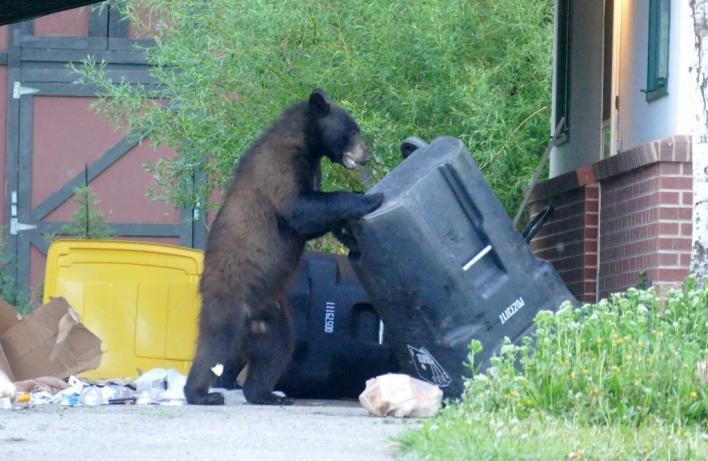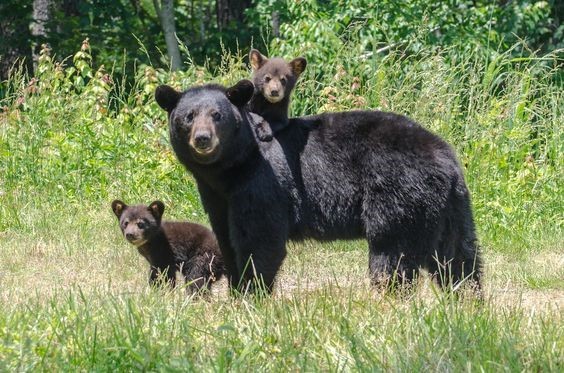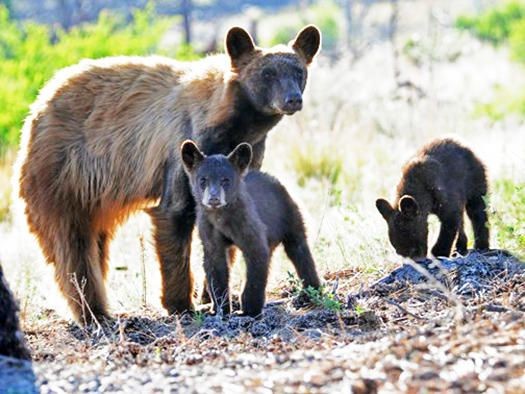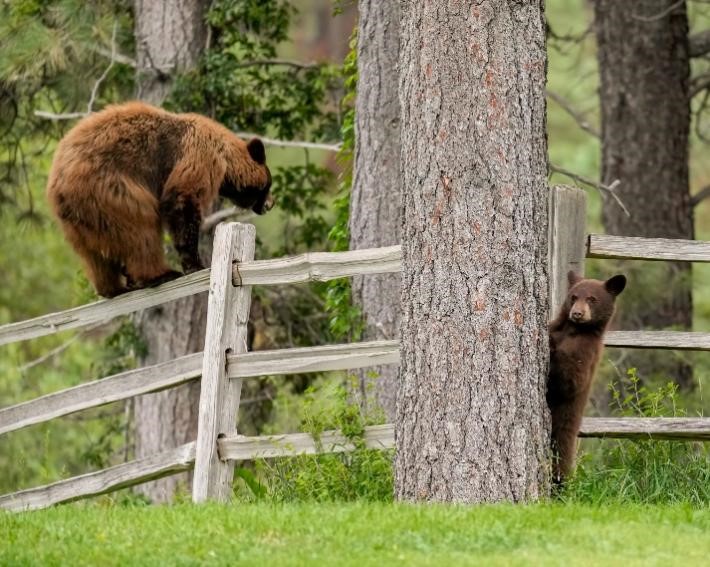By Terry Foxx
I recently participated in Bear Fest. I have always been fond of bears and have done the celebration every year because I feel we anthropomorphize the bear too much. They are not cuddly teddy bears but real live wildlife that needs to be respected.
This year I told stories, such as the Teddy Bear’s Picnic, How Teddy Bears came about, How Bear lost his tail, the Gift of the Bear (Bear berry), and others. I wrote this story, but, because of the age of the children, I decided to share it as a blog. We all need to be Bear Wise in the Jemez Mountains. I learned a lot researching this story.
This story will help you understand what it means to be Bear Wise.


One day, not too long ago, a mother and two children were off for a walk along a trail in Los Alamos from the Kinnikinnik Park through Acid Canyon. The children were 2 and 5, a girl and a boy. They had not expected to see a black bear, however, Mom said they should be “bear wise”. Bears had been seen on trails and around town in Los Alamos. “If they get into garbage, they are considered nuisance bears and are killed,” she said. We want to be “bear wise” and make sure bears are not considered nuisance bears! A garbage fed bear is a dead bear. Get a bear-proof trash can!
They decided not to take snacks because a bear’s sense of smell is 100 times greater than humans. A bear can smell their snack a long way away, even if they are not going to walk far.
The bear hibernates 6-7 months of the year without eating or drinking. So when hibernation is over, they are trying to fatten up for another year of hibernation. “They are eating machines,” said Mom.
“Did you know bears need to eat 20,000 calories a day before they hibernate?” said Mom. “That is 36-40 Big Mac burgers a day. One Big Mac is 563 calories. Eat 36-to–40 Big Macs in one day and you’ll be on par with the American black bear’s ravenous appetite. To get the 20,000 calories a day a bear would need to eat 672 acorns, 78 pounds of blueberries, nearly 25,000 tent caterpillars or one 7-pound bird-feeder filled with black oil sunflower seeds (Bear Calorie Counter). That is why you don’t leave a bird feeder out!” said Mom. “One bird feeder with oily seeds is over 18,000 calories so bears really want to find them.!” “Wow! That is a lot of food,” said the little boy.
“A boy needs only 1,600 calories at the maximum and I need only about 2000 calories or less a day,” said Mom. “Bears eat plants, grubs, and garbage, among other things, and are called omnivores. That means they eat both plants and animal food. Humans are omnivores too,” said Mom.
As they walked along, they chatted about what they saw. “Look!” said the older boy, “there’s a sunflower. Sunflowers are important to bees. They collect nectar and pollen which is used to make honey. Bears love stumps and trees with hollow trunks, and they don’t just eat honey but the whole hive—larvae and all.”
The little girl, whined “I’m tired, carry me!” “Let’s walk a little longer,” said Mom.
“Oh look, look!” said the 5-year old excitedly, “a bear!” Mom stopped him from running closer to the bear. “STOP!” she demanded. Be ‘bear wise’! Black Bears hearing is very acute.”
In the distance they saw a large black bear rambling along. She was brownish in color rather than black. Her muzzle was even lighter. She was making grunts and clicking noises, talking to her two cubs.
Excitedly, the little boy spoke “I would call her Hunk she is so big. I think I see two baby bears following her. I think she is teaching them how to find food” Just then the bear tore apart a huge stump and the bees swarmed. The cubs scrambled and the bear took out the whole hive. The power to tear apart a log amazed the family.
“Let’s run,” said the 5-year-old. “NO DON’T RUN”, the mother said STERNLY. Running will attract the bear and it can run faster than us, as fast as 30 miles an hour! And don’t even think about climbing a tree, bears can climb trees too! You might get trapped.” In fact, when she comes out of hibernation, she finds a babysitting tree and sends the cubs up while she looks around.” They climb up the tree and wait for her.
She picked up the 2-year-old and said, “be very quiet, we don’t want to get between the bears, especially the mother and her young. The little ones can climb a tree and little bears cry just like human babies—please don’t cry, Momma bear might mistake your cry for a cub.”
“Let’s Just back away slowly and make yourself as big possible” she said to the 5-year-old. “Put your hands above your head and wave them but talk very quietly. The bear is probably more scared of us than we are of them. Talk easily, “Hey bear, we are just out for a nice walk. We don’t want to disturb you or your babies.”
In a few minutes the bear wandered off with her young. “Black bears are more timid than grizzly bears,” said the mom. “Black bears will sometimes run from butterflies.” Grizzly bears don’t occur in the Jemez Mountains, they are commonly found in Alaska, Washington, Montana, and Idaho (mostly northern states), and have a hump on their back and big claws. They are larger than a black bear and always cinnamon colored.
“Wow, said the little boy, I am glad you are ‘BEAR WISE’ and I hope everyone else is too!” The bear continued wandering the woods, hoping to find something to eat! She tore apart stumps to find bee colonies, ate berries, grass, and grubs.
Do you think she managed to eat 20,000 calories that day?
Mom said to the kids, “Let’s turn around. We have seen enough today. What an adventure! Put it in your journal and remember to always be ‘bear wise’.”
Some Notes…
Honeybees: Did you know that honeybees are not native to North America? They were imported from Europe a long time ago. Honeybees are very important to many of the things we eat. And since 1950 they have decreased by 50%. We need to save the bees and bears. Find books and other reading material to educate yourself on how to save the bees.
Black Bear attacks: It is important to note that a black bear attack is rare and occurs mostly when the individual is between the mother and her cubs. They protect their cubs! If a bear attack occurs, DON’T PLAY DEAD, Fight back! Hit them in the nose and other vulnerable places. If the attack continues, put your hand around the back of your neck and lay flat on your stomach. You don’t want the bear to roll you over to get to your belly or bite your neck and spine!
Learn More…
For further information about being Bear Wise watch this video by PEEC’s educator Kristin O’Hara.
Here is a fun bear calorie counter!
Read “Staying Safe Around Bears” by the National Park Service.
Explore resources at the North American Bear Center in Ely, Minnesota.







E XCELLENT! PL WRITE REGULARLY!NATHAN